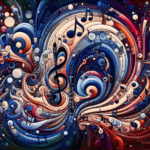The C# Whole-Tone Scale: A Hidden Gem in Clarinet Music
The C# Whole-Tone Scale is a fascinating musical element that's often overlooked in clarinet music. But did you know this scale is more than just a sequence of notes? It's a goldmine of musical possibilities that can change how we approach melody and harmony, making it an essential tool for clarinetists.

Clarinet Fingering Charts are always FREE at MartinFreres.net!
Understanding the Whole-Tone Scale
The whole-tone scale breaks away from the traditional half-step and whole-step system. Instead, it flows smoothly with each note a whole step apart from the next. This simple concept creates a magical, otherworldly quality that sounds beautiful on the clarinet, giving it a voice that can whisk listeners away to another dimension.
Historical Significance in Clarinet Music
Composers in the late 19th and early 20th centuries, particularly the Impressionists like Claude Debussy, used the C# Whole-Tone Scale to explore new musical territories. These innovative musicians used the scale's unique sound to evoke emotions and paint vivid scenes. For clarinetists, this scale provides a special way to express mood changes, allowing pieces to flow smoothly from one idea to the next.
| Era | Composers | Influence on Clarinet Music |
|---|---|---|
| Late 19th Century | Claude Debussy | Introduced ethereal qualities in compositions |
| Early 20th Century | Maurice Ravel | Expanded use in impressionist clarinet pieces |
| Mid 20th Century | Olivier Messiaen | Incorporated into avant-garde clarinet works |
Unique Characteristics of the C# Whole-Tone Scale
One of the most intriguing aspects of this scale is its ambiguity. It doesn't have a strong tonal center, which can leave listeners feeling curious and excited. Picture yourself playing a piece using the C# Whole-Tone Scale—it's like opening a door to unexplored sound territories. This sense of discovery is exhilarating! It's almost like walking through a magical forest, where each note guides you deeper into an enchanted realm.
Applications in Different Musical Genres
The C# Whole-Tone Scale fits into various musical styles. Jazz musician Jonny Dodds, who played both violin and clarinet, made an impact by incorporating the whole-tone scale into his melodies. In today's music scene, clarinetists continue to push the boundaries of this scale. Whether you're playing jazz improv or breathing life into modern compositions, the C# Whole-Tone Scale serves as a link between traditional and contemporary musical expressions.
Practical Benefits for Clarinet Players
Looking at the practical side, how can this scale improve a clarinetist's skills? Practicing the scale can boost your technique—it challenges you, promoting agility and precision in your finger movements. Give it a try! Play it going up, then down, add some variations, and you'll notice those familiar notes turning into a musical adventure all their own.
Improvisation and Performance Applications
As you get more familiar with the C# Whole-Tone Scale, don't hesitate to improvise. Create short passages where this scale can shine. Use it as a foundation in your practice sessions—crafting solos that tap into its dreamy, fanciful nature. If you're getting ready for a performance, adding a phrase or two from this scale can really impress your audience, taking them on a fantastic musical journey.
The C# Whole-Tone Scale in Ensemble Settings
In orchestras and ensembles, the C# Whole-Tone Scale can add a special touch. Think about how it can bring new tones to a clarinet's role. Does it make a soloist stand out? Or does it allow the whole group to explore new sound textures? In jazz groups, whole-tone scales often go along with modal changes, giving the clarinet a chance to take center stage with renewed energy.
Balancing Tradition and Innovation
Does embracing the C# Whole-Tone Scale mean giving up on traditional scales and styles? Not at all! Instead, it offers a rich contrast—a way to keep the old while moving towards something new. Whether you play for fun, in school, or professionally, playing around with this scale can really boost your musical skills. Want to wow other musicians? Try weaving this scale into a classic piece and watch them be amazed!
Conclusion: Embracing the C# Whole-Tone Scale
To sum up, the C# Whole-Tone Scale is more than just a set of notes; it's a doorway to the expressive world of clarinet music. Whether you're an experienced player or just starting out, exploring this scale's history and uses can lead to great rewards in your musical journey. So grab your clarinet, open up that scale book, and start your musical adventure!
Table of Contents
- The C# Whole-Tone Scale: A Hidden Gem in Clarinet Music
- Understanding the Whole-Tone Scale
- Historical Significance in Clarinet Music
- Unique Characteristics of the C# Whole-Tone Scale
- Applications in Different Musical Genres
- Practical Benefits for Clarinet Players
- Improvisation and Performance Applications
- The C# Whole-Tone Scale in Ensemble Settings
- Balancing Tradition and Innovation
- Conclusion: Embracing the C# Whole-Tone Scale








